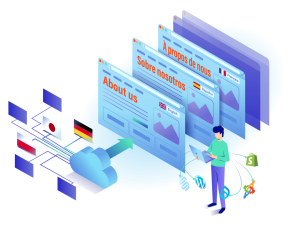In the age of globalization and the internet, the need for website translation has evolved from being a luxury to an absolute necessity. As we navigate through an increasingly interconnected world, the capability to communicate in multiple languages has become pivotal for both individuals and businesses. Whether seeking to access specialized knowledge, aiming to engage with a culturally diverse audience, or preparing to expand your business to international markets, the language challenge must be met head-on.
The Rising Need for Website Translation
A variety of factors fuels this urgent requirement for translation. For individuals, it could be the quest for academic research, cultural exploration, or personal enrichment. For businesses, it’s not just about spreading brand awareness; it’s about building customer relationships, adapting to local market demands, and maintaining a competitive edge. In such contexts, translation becomes less of a ‘nice-to-have’ and more of an operational imperative.
The market offers various tools and services to assist you in hurdling language barriers. These options cover the entire range in terms of quality and price, from basic machine translation to professional website localization, and they differ in price points from free to premium. But how do you know if free tools will suffice?
Before answering that question, let’s look at free online translation tools.
A Closer Look at Free Translation Options
1. Translate a website in Microsoft Edge
Translating a website in Microsoft Edge is simple, thanks to its integrated translation feature When you visit a webpage not in your default browser language, a translation prompt should automatically appear at the top of the screen, asking if you’d like to translate the page. By clicking “Translate,” the page will be automatically converted to your default language. If the prompt doesn’t appear, you can manually initiate the translation by right-clicking on an empty area of the webpage and selecting “Translate to [your default language]” from the context menu.
2. Translate a website in Chrome
Translating a website in Google Chrome is also straightforward, thanks to its built-in translation feature. When you navigate to a webpage in a language different from your default browser language, a translation bar should automatically appear at the top of the screen. You can choose to “Translate” the page from this bar, and Chrome will automatically translate the text into your preferred language. If the bar doesn’t appear, right-click anywhere on the page and select “Translate to [your default language]” from the context menu to initiate the translation.
3. Translate a website in Safari
In Safari, translating a website involves using the built-in translation feature available in newer versions or third-party extensions for older versions.
If you’re using a newer version, you’ll see a translation icon (it looks like an ‘A’) appear in the address bar when you visit a website in a foreign language. You can choose to translate the page into your preferred language by clicking on this icon.
For older versions of Safari or more advanced features, you can also download translation extensions from the Safari Extensions Marketplace to enable seamless web page translation.
4. Translate a website in Firefox
Translating a website in Firefox requires a slightly different approach, as the browser doesn’t have a native translation feature like Chrome. However, you can easily add this capability by installing translation add-ons such as “To Google Translate” or “Simple Translate” from the Firefox Add-ons Marketplace. Once installed, these extensions usually add a right-click context menu option or a toolbar icon for easy access. To translate a page, you can either right-click on the text you want to translate and choose the appropriate option or click the toolbar icon, depending on the add-on you’ve selected, to translate the entire page into your desired language.
5. Translate a website using Google Translate
Using Google Translate to translate a website is an easy and convenient method that works across various browsers. Go to the Google Translate website and enter the website URL you wish to translate in the box provided for the original text. Then, select the target language using the dropdown menu on the right. Once you’ve done this, click the ‘Translate’ button, and Google Translate will generate a link to the translated website. Clicking on this link will take you to a fully translated version of the original website, allowing you to browse it as you would any site in your native language.
6. Translate a website on an iPhone
Translating a website on an iPhone is easy if you’re using Safari as your browser. On newer versions of Safari, you can tap on the “Aa” icon in the address bar to bring up a menu where you’ll find the “Translate” option. Select it, then choose the language you want the page translated into. If you’re using a different browser like Chrome on your iPhone, you’ll typically get a translation prompt at the bottom of the screen when you visit a site in a foreign language. Tap “Translate” to convert the page to your phone’s default language. This makes reading content and navigating websites on your iPhone easier, regardless of the original language.
7. Translate a website on an Android Device
Translating a website on an Android mobile device is simple, especially if you’re using browsers like Google Chrome. In Chrome, when you navigate to a website in a foreign language, a translation prompt usually appears at the bottom of your screen. Tapping on “Translate” will instantly convert the page into your device’s default language. If the prompt doesn’t appear, you can manually initiate translation by tapping the three vertical dots in the upper right corner to access the menu and then selecting “Translate.” This will change the webpage’s language to your default setting, making it easier to read and navigate.
Advantages and Limitations of Free Tools
Free translation tools have become an invaluable resource in today’s interconnected society. Accessible across desktop and mobile platforms, they offer a highly convenient and user-friendly way to overcome language barriers, whether browsing the internet for personal reasons or pursuing academic research.
The benefits of utilizing free translation tools are multiple:
Research and Information Gathering: For those embarking on research projects or simply seeking information primarily available in foreign languages, these tools provide an instant bridge to otherwise inaccessible content.
Travel Convenience: Frequent travellers who traverse various countries will find free translation tools invaluable for understanding local news, navigating public transportation systems, and discovering local points of interest.
Academic Advantages: Students and educators may need scholarly articles, textbooks, and other educational resources that are not readily available in their native language.
Global Communication: In a world where international interactions are becoming the norm, these tools can facilitate building relationships and connecting across different linguistic communities.
While free translation tools offer numerous advantages, particularly for individual users and small-scale tasks, they have limitations. Their primary drawback is the inconsistency in the quality of translations. While translating between commonly spoken languages like English and German might yield relatively accurate results, the translation quality tends to degrade for less common or more syntactically complex language pairs, such as Slovak to Japanese. Such translations may suffer from inaccuracies and can sometimes lead to misunderstandings.
Another critical limitation is their need for more suitability for professional or business contexts. Automated translations may need more nuanced understanding and cultural contextualization, which are crucial for professional communications. When considering making your website multilingual as a part of a broader business strategy—to broaden your market reach, improve customer engagement, or elevate your revenue streams, for example—relying solely on these free tools may not yield the desired outcomes.
In summary, free translation tools offer a variety of benefits for personal and educational purposes, but they are not a one-size-fits-all solution. Their limitations, especially regarding the quality of translation and suitability for professional use, mean that they should be used judiciously and supplemented with professional services for more critical tasks.
The Added Value of Professional Website Translation
Contrasting with the limitations of free translation tools, paid website translation services provide a superior level of accuracy, context, and nuance that is often unattainable through automated means. These premium services typically employ several professional translators who bring their specialist knowledge in various fields – law, medicine or business – to the table. This ensures that the translated content remains faithful to its original context and conveys the intended meaning.
In addition to the high-quality translations, many of these professional services offer various supplemental features tailored to business needs. These can include Search Engine Optimization (SEO) capabilities for multiple languages, essential for increasing your website’s visibility on global search engines. They also often offer dedicated customer support channels to assist you through any challenges or adjustments in your translation project. Importantly, these services are designed to manage large volumes of content, providing scalability that is particularly beneficial for businesses looking to expand their global footprint.
Given these advanced features and the capability to ensure precise, culturally sensitive translations, professional website translation services emerge as a compelling choice, especially in business contexts where accuracy isn’t just a preference but a critical requirement.
Whether you are navigating regulatory compliance, establishing a multilingual customer service strategy, or launching products in new markets, these premium services are designed to meet and exceed the high stakes associated with such endeavours.
Why Choose TextUnited for your website translation?
Regarding website translation, TextUnited is the platform you need for a seamless and professional process. With our range of capabilities, you can expect the best results possible.
- Our enterprise-grade translation management system allows you to manage your team of translators and translation projects effectively.
- Thanks to our cutting-edge translation memory integrated with adaptive machine translation, you can pre-translate your website and achieve a high-quality draft that’s ready for post-editing by translators.
- We also offer a company terminology system to maintain consistency in your multilingual terms across your website and other online and offline content.
- You can integrate your website with TextUnited via a crawler or WordPress plugin or process translation as XML or XLIFF files in batches to get automated or semi-automated translations of the content.
- We even provide linguistic quality assurance checkpoints and access to on-demand managed services by our expert translators.
At TextUnited, we prioritize consistent terminology and brand voice across languages, ensuring your website translation needs are functional and strategically effective.
Want to learn more? Contact us or start your free trial today!


